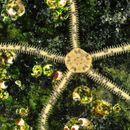en
names in breadcrumbs


Cosmopolitan in temperate and warm temperate seas, intertidal to more than 200 m depth. Common among algae in tidepools and under stones in gravel.
In Panama this species has been collected from both the eastern Pacific and the Caribbean Sea. In the Pacific it was collected from Panama Bay (USNM E 27229, USNM E 27230, USNM E 27225, USNM E 27237, Centroid Latitude: 8.8769, Centroid Longitude: -79.5567), Gulf of Panama, while in the Caribbean Sea it is recorded from North of Palina Island (USNM 1117663 & USNM 1117664; Centroid Latitude: 9.6131, Centroid Longitude: -79.5972), Colon, and from Fort Randolph (USNM E 26409), Margarita Island, Limon Bay, from shallow water.
Amphipholis squamata is a species complex, the individual species only distinguishable by molecular markers (see Le Gac et al., 2004)
Clark, A.M. and J. Courtman-Stock. (1976). The echinoderms of southern Africa. Publ. No. 766. British Museum (Nat. Hist), London. 277 pp.
Clark, A.M. (1977). The South African Museum's Meiring Naude cruises, part 4: Echinoderms. Ann. S. Afr. Mus. 73(6):; 133-147.
Gosner, K.L. (1971). Guide to identification of marine and estuarine invertebrates: Cape Hatteras to the Bay of Fundy. John Wiley & Sons, Inc. 693 p.
Hansson, H.G. (2001). Echinodermata, in: Costello, M.J. et al. (Ed.) (2001). European register of marine species: a check-list of the marine species in Europe and a bibliography of guides to their identification. Collection Patrimoines Naturels, 50: pp. 336-351.
Linkletter, L.E. (1977). A checklist of marine fauna and flora of the Bay of Fundy. Huntsman Marine Laboratory, St. Andrews, N.B. 68 p.
Mah, C.L., D.G. McKnight, M.K. Eagle, D.L. Pawson, N. Ameziane, D.J. Vance, A.N. Baker, H.E.S. Clark, and N. Alcock. (2009). Phylum Echinodermata. In Gordon, D.P. (Ed.) The New Zealand Inventory of Biodiversity. Volume 1. Kingdom Animalia: Radiata, Lophotrochozoa, Deuterostomia. Canterbury University Press, Christchurch; 371-400.
Muller, Y. (2004). Faune et flore du littoral du Nord, du Pas-de-Calais et de la Belgique: inventaire. [Coastal fauna and flora of the Nord, Pas-de-Calais and Belgium: inventory]. Commission Régionale de Biologie Région Nord Pas-de-Calais: France. 307 pp.
Pawson, D. L., D. J. Vance, C. G. Messing, F. A. Solis-Marin, and C. L. Mah. (2009). Echinodermata of the Gulf of Mexico, Pp. 1177–1204 in Felder, D.L. and D.K. Camp (eds.), Gulf of Mexico–Origins, Waters, and Biota. Biodiversity. Texas A&M Press, College S.
Southward, E.C.; Campbell, A.C. (2006). [Echinoderms: keys and notes for the identification of British species]. Synopses of the British fauna (new series), 56. Field Studies Council: Shrewsbury, UK. ISBN 1-85153-269-2. 272 pp.
Trott, T.J. (2004). Cobscook Bay inventory: a historical checklist of marine invertebrates spanning 162 years. Northeastern Naturalist (Special Issue 2): 261 - 324.
LSID urn:lsid:marinespecies.org:taxname:125064
Hermaphrodite, possibly self-fertilising, viviparous. Broods young in bursal slits near arm attachment sites.
Amphioplus squamata (Delle Chiaje, 1828)
Amphipholis appressa Ljungman, 1872
Amphipholis australiana H.L. Clark, 1909
Amphipholis elegans (Farquhar, 1897)
Amphipholis japonica Matsumoto, 1915
Amphipholis kinbergi Ljungman, 1872
Amphipholis lineata Ljungman, 1872 (synonym)
Amphipholis minor (Döderlein, 1910)
Amphipholis tenera (Lütken, 1856) (synonym)
Amphipholis tenuispina (Ljungman, 1865) (synonym)
Amphipholis tissieri Reys, 1961
Amphiura elegans Farquhar, 1897 (synonym)
Amphiura neglecta Forbes, 1843
Amphiura parva Hutton, 1878
Amphiura squamata Delle Chiaje, 1828
Amphiura tenera Lütken, 1856
Amphiura tenuispina Ljungman, 1865 (synonym)
Asteria squamata Delle Chiaje, 1828
Asterias noctiluca Viviani, 1805 (according to Millott in Boolootian (1966))
Asterias squamata Delle Chiaje, 1828 (synonym)
Axiognathus squamata (Delle Chiaje, 1829) (synonym)
Ophiactis minor Döderlein, 1910
Amphipholis squamata, common names brooding snake star and dwarf brittle star, is a species complex[2][3] of brittle stars in the family Amphiuridae.[4][5][6]
This species is small, grey to bluish-white, and phosphorescent. It has thin, short arms around 20 mm long. The round disc is 3 to 5mm, and has a scale covering with D-shaped radial plates. It has rhombic-shaped mouth shields and extremely wide mouth papillae.
Amphipholis Squamata is found in all parts of the British Isles and also in Ireland. It has been recorded in many other parts of the world and molecular studies have shown that there are multiple species in this complex.[2]
This brittle star lives in the intertidal zone in shallow water, and can be found under large stones, shells, and around sessile invertebrates such as bryozoans.
This brittle star hosts at least two species of ectoparasites. The following two that have been confirmed are both copepods:

Amphipholis squamata, common names brooding snake star and dwarf brittle star, is a species complex of brittle stars in the family Amphiuridae.